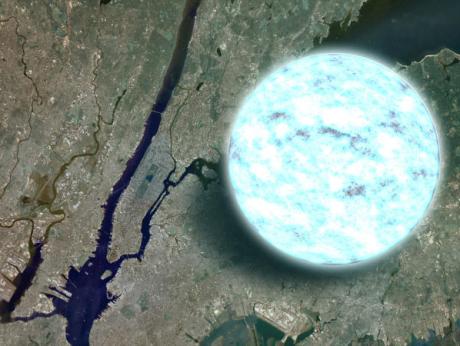Astronomy news
Neutron star surface explosions
captured in detail
23 May 2012
A neutron star is the equivalent of half a million Earths squeezed into
a sphere only 15 kilometres in diameter. In October 2010, one such star
near the centre of our galaxy erupted with hundreds of X-ray bursts
powered by a barrage of thermonuclear explosions on its surface. NASA's
Rossi X-ray Timing Explorer (RXTE) captured the month-long display in
extreme detail. An international team of astronomers has been able to
use this data to bridge a long-standing gap between theory and
observation.

This illustration compares the size of a neutron star to Manhattan. The
crushed core of a star that has exploded as a supernova, a neutron star
packs more mass than the sun into a sphere just 10 to 15 miles wide.
(Credit: NASA/Goddard Space Flight Center)
"In a single month from this unique system, we have
identified behaviour not seen in observations of nearly 100 bursting
neutron stars during the past 30 years," said Manuel Linares, a
postdoctoral researcher at the Kavli Institute for Astrophysics and
Space Research at the Massachusetts Institute of Technology in
Cambridge. He led a study of the RXTE data that will be published in the
March 20 issue of The Astrophysical Journal.
On 10 Oct 2010, the European Space Agency's INTEGRAL satellite
detected a transient X-ray source in the direction of Terzan 5, a
globular star cluster about 25,000 light-years away toward the
constellation Sagittarius. The object, dubbed IGR J17480-2446, is
classed as a low-mass X-ray binary system, in which the neutron star
orbits a star much like the sun and draws a stream of matter from it. As
only the second bright X-ray source to be found in the cluster, Linares
and his colleagues shortened its moniker to T5X2.
Three days after the source's discovery, RXTE targeted T5X2 and detected
regular pulses in its emission, indicating that the object was a pulsar
— a type of neutron star that emits electromagnetic energy at periodic
intervals. The object's powerful magnetic field directs infalling gas
onto the star's magnetic poles, producing hot spots that rotate with the
neutron star and give rise to X-ray pulses.
At NASA's Goddard Space
Flight Center in Greenbelt, Md., RXTE scientists Tod Strohmayer and
Craig Markwardt showed that T5X2 spins at a sedate — for neutron stars
— rate of 11 times a second. And because the pulsar's orbital motion
imparts small but regular changes in the pulse frequency, they showed
that the pulsar and its sun-like companion revolve around each other
every 21 hours.
That same day, RXTE observed its first burst from the system: an intense
spike in X-rays lasting nearly 3 minutes and caused by a thermonuclear
explosion on the neutron star's surface. Ultimately, RXTE cataloged some
400 events like this between Oct 13 and Nov 19, with additional bursts
observed by INTEGRAL and NASA's Swift and Chandra observatories. NASA
decommissioned RXTE on Jan. 5, 2012.
In the T5X2 system, matter streams from the sun-like star to the neutron
star, a process called accretion. Because a neutron star packs more than
the sun's mass into a sphere between 10 and 15 miles across -- about the
size of Manhattan or the District of Columbia -- its surface gravity is
extremely high. The gas rains onto the pulsar's surface with incredible
force and ultimately coats the neutron star in a layer of hydrogen and
helium fuel.
When the layer builds to a certain depth, the fuel undergoes a runaway
thermonuclear reaction and explodes, creating intense X-ray spikes
detected by RXTE and other spacecraft. The bigger the blast, the more
intense its X-ray emission.
Models designed to explain these processes made one prediction that had
never been confirmed by observation. At the highest rates of accretion,
they said, the flow of fuel onto the neutron star can support continuous
and stable thermonuclear reactions without building up and triggering
episodic explosions.
At low rates of accretion, T5X2 displays the familiar X-ray pattern of
fuel build-up and explosion: a strong spike of emission followed by a
long lull as the fuel layer reforms. At higher accretion rates, where a
greater volume of gas is falling onto the star, the character of the
pattern changes: the emission spikes are smaller and occur more often.
But at the highest rates, the strong spikes disappeared and the pattern
transformed into gentle waves of emission. Linares and his colleagues
interpret this as a sign of marginally stable nuclear fusion, where the
reactions take place evenly throughout the fuel layer, just as theory
predicted.
"We see T5X2 as a 'model burster,' the one that's doing everything
expected of it," said Diego Altamirano, an astrophysicist at the
University of Amsterdam in The Netherlands and a co-author on the paper
describing the findings.
The question now before the team is why this system is so different from
all others studied in previous decades. Linares suspects that T5X2's
slow rotation may hold the key. Faster rotation would introduce friction
between the neutron star's surface and its fuel layers, and this
frictional heat may be sufficient to alter the rate of nuclear burning
in all other bursting neutron stars previously studied.
To top |